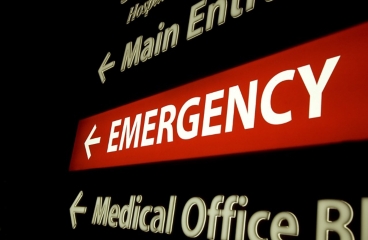Your Child's Health: Using the Emergency Room Wisely
Overview

What is the emergency room (ER)?
An emergency room (ER)—or emergency department—is a place where you go for a medical emergency. It's not for routine health care. An ER is often open 24 hours a day. You don't need an appointment.
When should you use the ER versus urgent care?
It may not be clear when your child needs to go to the ER. It can help to think about how bad the injury or symptom is. Often the more symptoms your child has, the more serious the problem is.
If your child is younger than 3 months old and has injuries or symptoms you're concerned about, take them to the ER right away.
When to use the ER
Severe or life-threatening injuries or symptoms need care right away. The problem may be severe or life-threatening if your child:
- Passes out (loses consciousness).
- Has moderate to severe trouble breathing.
- Has a head injury, such as from a fall or a car crash.
- Has bleeding that doesn't stop after you apply pressure for 5 minutes.
- Has a moderate or severe burn or burns on many areas of the body.
- Has seizures.
- Self-harms or talks about suicide.
- Was poisoned or has swallowed an object, such as a battery.
- Has a high fever with shaking or chills.
- Acts different. Maybe they're more withdrawn or less alert than usual.
When to use urgent care
Mild-to-moderate injuries or symptoms need care soon. The problem may be mild or moderate if your child:
- Has a sprain.
- Has a mild burn.
- Has a broken bone.
- Gets a wound that may need stitches.
- Is crying more than usual or is crying with a different type of cry than you're used to.
- Is nauseated or vomits and can't drink fluids, so they urinate less.
- Has mild trouble breathing.
- Has mild belly pain.
- Is coughing up a lot of mucus, or their cough is getting worse.
- Has signs of a skin infection.
- Has a sore throat or an earache.
What might you think about before taking your child to the ER?
Most health problems aren't emergencies. But sometimes the ER may be the quickest way to get the care your child needs.
If you're not sure about how serious your child's symptoms are or where to take them for care, it's okay to take them to the ER.
Before you go to the ER, you might ask yourself:
- Is the ER convenient or necessary?
- Is there another option (such as an urgent care clinic or a walk-in clinic) that I can get to?
- How serious are my child's symptoms?
Know that if you go to the ER for a problem that's not an emergency:
- It may take a long time to see a doctor.
- Your child will be seen by a doctor who doesn't know their past health.
- It may cost a lot.
How can you prepare for your child's ER visit?
Try to stay calm. This can help your child be calm too. Here are some ways you can help yourself and your child.
- Take some deep breaths.
- Tell your child what to expect.
Let them know that they'll wait awhile at the ER. They'll see a different doctor than they usually do. Talk with them in a way that suits their age and the situation you're both in.
- Bring a comfort item.
Maybe that's a stuffed animal, a book, or a blanket. If you can, bring a new toy. It can be a welcome distraction.
- Leave siblings at home, if you can.
This can help you focus on the child who needs care.
- Plan ahead for emergencies.
Here are some ideas:
- Know where you'll take your child for care. Find the closest ER to you. And see if there's a pediatric ER in your area. Find out which urgent care and walk-in clinics are close to you. Know which hospital your child's doctor prefers.
- Have your child's information ready. This may include health insurance, any known allergies, a list of medicines your child takes, the name of your child's doctor, and any past medical problems.
- Ask about virtual care visits. Find out if your doctor's office, hospital, or health clinic offers virtual care (telehealth) with a doctor or nurse.
- Keep important medicine ready at home. In some cases, you may be able to treat your child at home first. Over-the-counter (OTC) pain medicine for mild pain or fevers can help. Take note of the time and the dose that was given.
- Save important phone numbers. And post them where you and others can easily find them. These can include the number for your child's doctor and the Poison Control Center (1-800-222-1222).
- Know where to go for mental health. If your child talks about suicide, self-harm, a mental health crisis, a substance use crisis, or any other kind of emotional distress, get help right away. If it's an emergency, call 911.
Where to get help 24 hours a day, 7 days a week:
- Call the Suicide and Crisis Lifeline at 988.
- Call 1-800-273-TALK (1-800-273-8255).
- Text HOME to 741741 to access the Crisis Text Line.
Consider saving these numbers in your phone.
Go to 988lifeline.org for more information or to chat online.
Related Information
Credits
Current as of: July 31, 2024
Author: Ignite Healthwise, LLC Staff
Clinical Review Board
All Healthwise education is reviewed by a team that includes physicians, nurses, advanced practitioners, registered dieticians, and other healthcare professionals.
Current as of: July 31, 2024
Author: Ignite Healthwise, LLC Staff
Clinical Review Board
All Healthwise education is reviewed by a team that includes physicians, nurses, advanced practitioners, registered dieticians, and other healthcare professionals.


